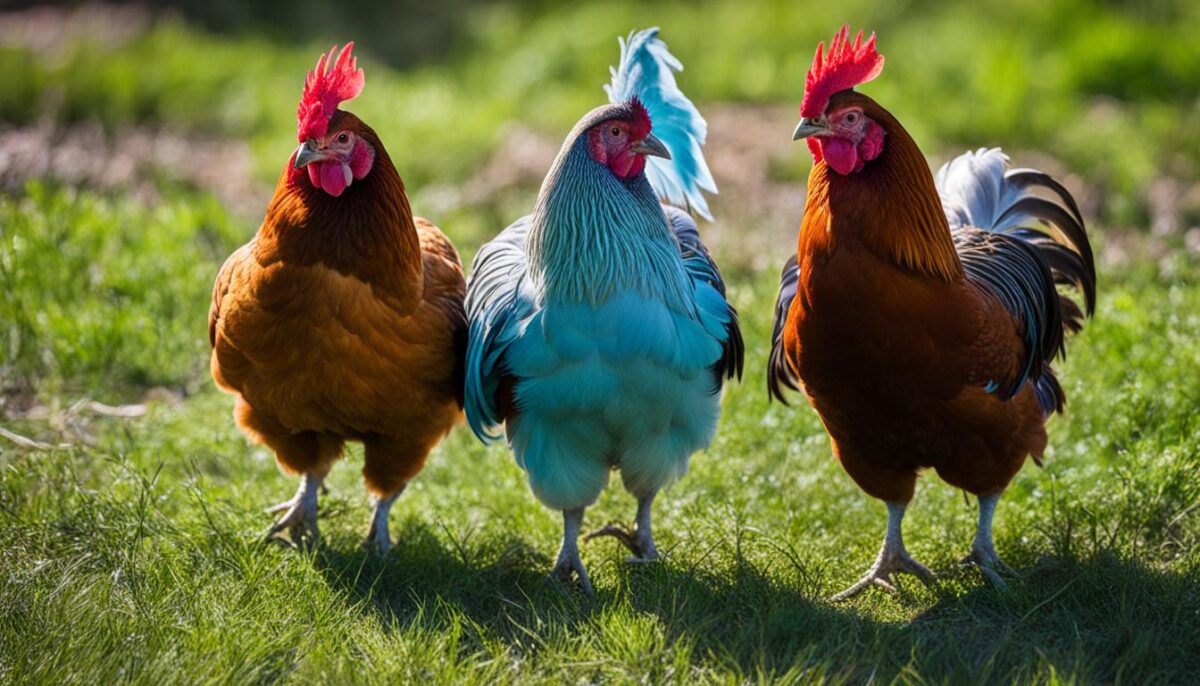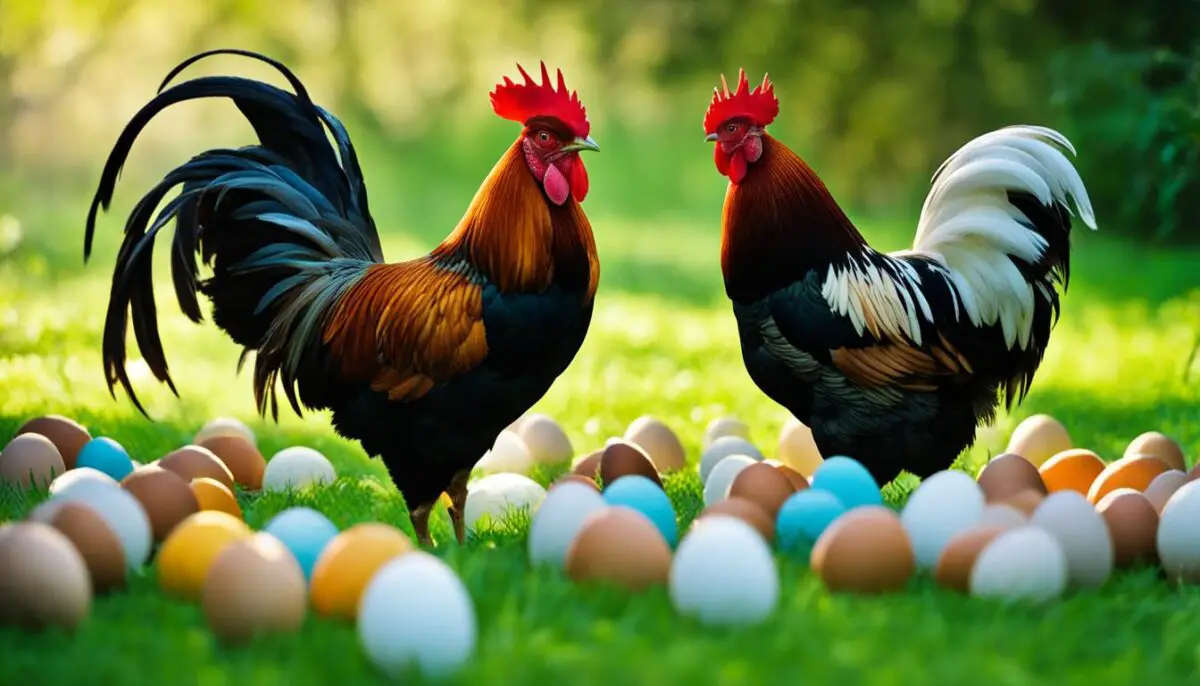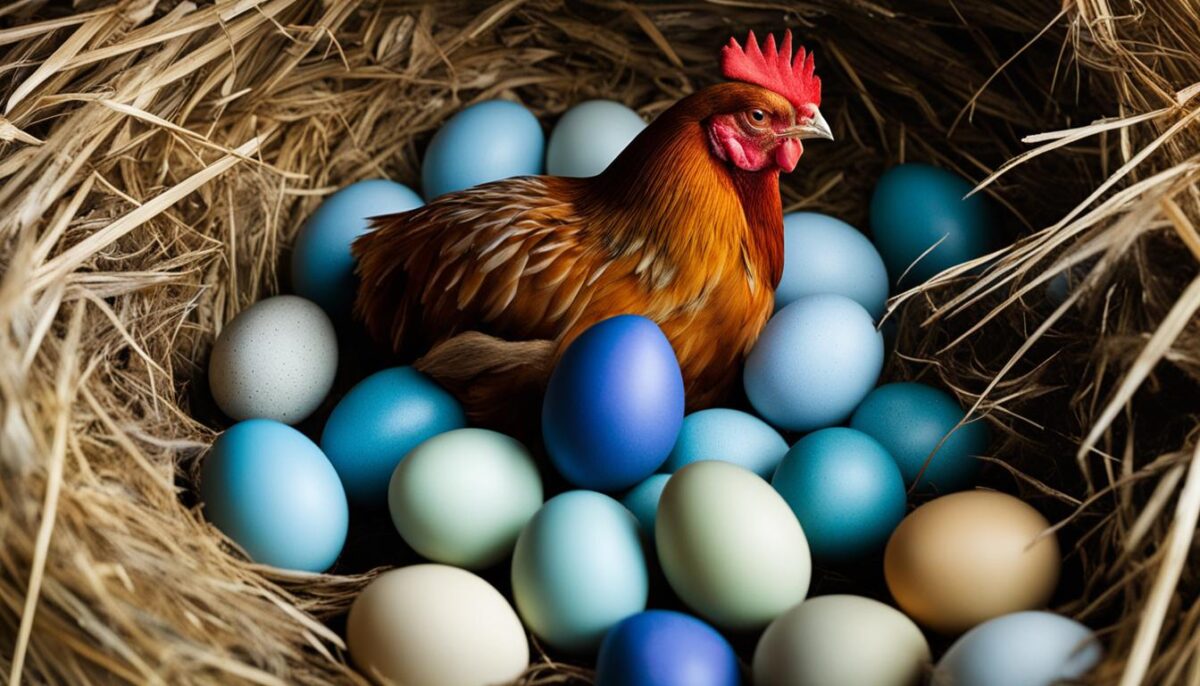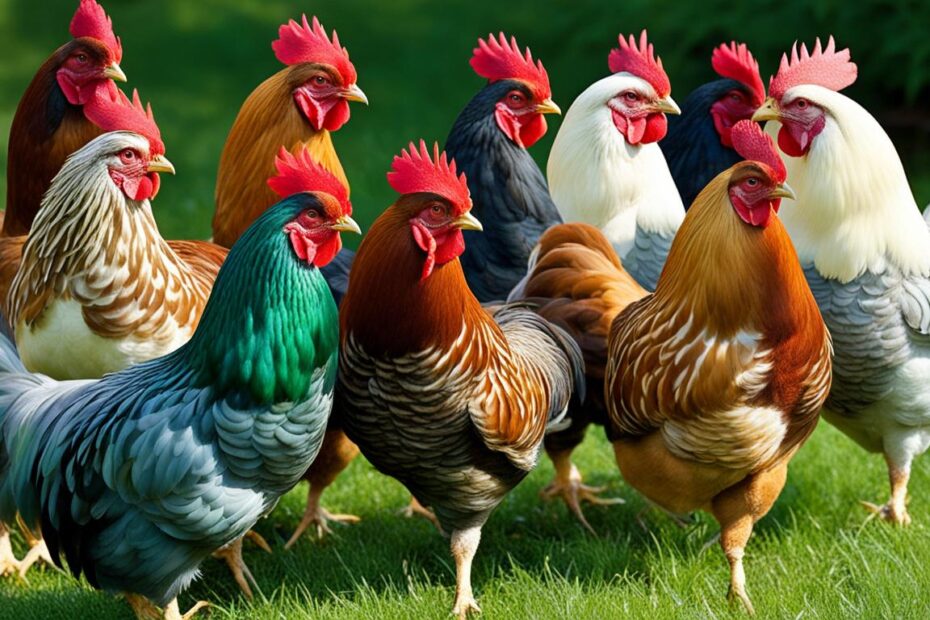When it comes to chicken breeds, the Ameraucana is known for its stunning array of colors. From black and blue to buff and white, these chickens come in a variety of shades that will add a pop of color to your flock. But it’s not just their vibrant plumage that sets them apart – Ameraucanas are also famous for their beautiful blue eggs. In this article, we will explore the different colors of Ameraucana chickens, their unique genetic traits, and why they are a popular choice for backyard chicken keepers.
Key Takeaways:
- Ameraucana chickens come in a range of colors, including black, blue, buff, and white.
- Each color variety has specific color standards that breeders must adhere to.
- Ameraucanas are known for their distinctive blue eggs, which add an extra element of novelty to your egg collection.
- Understanding the genetics of Ameraucana chicken colors is crucial in breeding and maintaining the breed’s unique traits.
- Backyard chicken keepers often choose Ameraucanas for their diverse colors and beautiful blue eggs.
Understanding the Difference Between Ameraucanas and Easter Eggers
When it comes to Ameraucanas and Easter Eggers, many people get confused as they both lay blue eggs. However, there are some key differences between these two breeds that are important to know. Ameraucanas are true breed chickens that meet the standards set by the American Poultry Association (APA), while Easter Eggers are crossbreeds that may carry the blue egg gene but also have influences from other breeds.
The APA has specific criteria for Ameraucanas, including their appearance, color standards, and other physical traits. They have muffs, blue slate legs, and unique coloring that distinguish them from Easter Eggers. On the other hand, Easter Eggers can come in various colors and appearances due to their mixed heritage. While both breeds lay blue eggs, Ameraucanas consistently produce eggs that adhere to the APA standard.
To ensure you are getting true Ameraucanas, it is important to purchase from reputable breeders who specialize in this breed. This will ensure that you are getting chickens that meet the specific breed standards. On the other hand, if you are looking for chickens that lay blue eggs but are not concerned with breed purity, Easter Eggers can be a great option as they can exhibit a wide range of colors and appearances.
| Ameraucanas | Easter Eggers | |
|---|---|---|
| Genetic Background | Purebred | Crossbreed |
| Blue Egg Gene | Present | Present |
| APA Standard | Meets APA standards | Does not meet APA standards |
| Physical Appearance | Muffs, blue slate legs, specific coloring | Varies due to crossbreeding |
In summary, understanding the difference between Ameraucanas and Easter Eggers is crucial when selecting chickens for their blue egg-laying abilities. If breed purity and adherence to specific standards are important to you, Ameraucanas are the way to go. However, if you are more interested in a wide range of appearances and color variations, Easter Eggers can provide a colorful and diverse egg-laying experience.
The Unique Characteristics of the Araucana Breed

The Araucana breed is a fascinating addition to the world of chickens. Known for their contribution to the blue egg craze, Araucanas have unique physical characteristics that set them apart from other breeds. These chickens have an upright stance and are often recognized for their tufts, comical feathers that grow near their cheeks. Additionally, Araucanas are rumpless, which means they lack long tail feathers.
Araucanas have pea combs and clean legs, adding to their distinctive appearance. The color of their legs can vary, depending on the variety of Araucana and its feather colors. Speaking of feather colors, Araucanas come in several varieties, including black, red, silver duck wing, white, and golden duck wing. Each variety has its own charm and visual appeal.
The combination of their unique physical traits, such as their upright stance, tufts, and rumplessness, along with their colorful feather varieties, make Araucanas a sought-after breed among chicken enthusiasts. And let’s not forget their contribution to the blue egg craze, adding a touch of novelty and excitement to any egg collection.
Finding Purebred Ameraucanas and Ameraucana Crosses
If you are interested in adding Ameraucanas to your flock, it is important to find reputable breeders who specialize in purebred Ameraucanas. Purchasing from these breeders ensures that you are getting true Ameraucanas that meet the breed’s specific appearance and color standards. These chickens will lay beautiful blue eggs and exhibit the unique characteristics of the breed, such as muffs, blue slate legs, and specific coloring.
On the other hand, if you come across chickens labeled as Ameraucanas in hatcheries, they are most likely Easter Eggers or hybrids that carry the blue egg gene but have other breed influences. While Easter Eggers are still popular choices for backyard chicken keepers due to their blue egg-laying abilities, it is important to understand the difference between them and purebred Ameraucanas.
When it comes to finding Araucanas, another breed known for its blue eggs, they can be more challenging to find in the United States. Consulting with dedicated breeders who specialize in Araucanas may be necessary to acquire these unique chickens. Whether you are looking for purebred Ameraucanas or Ameraucana crosses, it is crucial to do your research and connect with reputable breeders to ensure you are getting the chickens you desire.
Breeding for Chicken Egg Color
When it comes to breeding chickens for specific egg colors, understanding the genetics of egg shell color genes is essential. Chickens carry two egg shell color genes: dominant blue and recessive white. The combination of these genes determines the color of the eggs they lay. Additionally, some breeds also carry tint overlay genes, which deposit a brown overlay color on the eggshell. By selectively breeding chickens with specific color genes, you can achieve a diverse range of egg colors in your flock.
One of the key factors in breeding for specific egg colors is the presence of homozygous blue genes. Chickens with homozygous blue genes, such as purebred Ameraucanas or Crested Cream Legbars, consistently lay vibrant blue eggs. These breeds are carefully selected to possess two copies of the blue egg gene, ensuring a consistent egg color in their offspring.
By crossing blue egg layers with dark brown egg layers, you can create olive eggers that lay shades of green or brownish-green eggs. The first generation, known as F1 Olive Eggers, will exhibit varying shades of olive. Backcrossing the F1 Olive Egger hens with dark layer roosters can result in darker olive eggs. However, it’s important to note that backcrossing may produce muddy brown tones with muted hints of green, rather than vibrant green eggs.
| Egg Color Genetics | Description |
|---|---|
| Dominant Blue | Chickens carry two copies of the dominant blue egg shell color gene, resulting in vibrant blue eggs. |
| Recessive White | Chickens carry two copies of the recessive white egg shell color gene, resulting in white eggs. |
| Tint Overlay Genes | Some breeds carry tint overlay genes, which deposit a brown overlay color on the shell of the eggs, resulting in tinted eggs. |
| Homozygous Blue | Chickens with two copies of the blue egg gene consistently lay vibrant blue eggs. |
“By selectively breeding chickens with specific color genes, you can achieve a diverse range of egg colors in your flock.”
It’s important to keep in mind that the color of eggs a hen lays is determined by her genetics, not the rooster she mates with. Mating a blue or green egg laying hen with a Marans rooster, known for hatching from dark chocolate eggs, will not change the color of the hen’s eggs. The resulting offspring will also lay blue or green eggs based on their inherited genetics.
Breeding for specific egg colors can be a fun and rewarding venture for backyard chicken keepers. By understanding the genetics of egg shell color genes and selectively breeding chickens with specific color traits, you can create a visually stunning and diverse egg carton that will delight family and friends.
The Role of Roosters in Egg Color Genetics

When it comes to breeding chickens for specific egg colors, understanding the role of roosters in egg color genetics is essential. Contrary to popular belief, the color of the eggs a hen lays is determined by her genetics, not the rooster she mates with. The rooster’s genes play a vital role in determining the traits of the offspring, but they do not directly influence the color of the eggs.
For example, mating a blue or green egg-laying hen with a Marans rooster, known for hatching from dark chocolate eggs, will not change the color of the hen’s eggs. The resulting offspring will also lay blue or green eggs, depending on their inherited genetics. This highlights the importance of selecting hens with the desired egg color genes when breeding for specific egg colors.
“The color of the eggs a hen lays is determined by her genetics, not the rooster she mates with.”
Understanding the role of roosters in egg color genetics can help backyard chicken keepers make informed breeding decisions. By focusing on selecting hens with the desired egg color genes and pairing them with roosters that possess other desired traits, such as temperament or appearance, breeders can work towards achieving their desired egg colors while maintaining the other qualities they desire in their flock.
Table: Example Breeding Outcomes
| Hens | Roosters | Offspring Egg Colors |
|---|---|---|
| Blue or green egg-laying hen | Marans rooster | Blue or green eggs, depending on inherited genetics |
| Blue or green egg-laying hen | Blue or green egg-laying rooster | Blue or green eggs, depending on inherited genetics |
| White egg-laying hen | Blue or green egg-laying rooster | Blue or green egg-laying Easter Eggers |
By focusing on the genetics of the hens and selecting roosters with genes that complement the desired egg colors, breeders can work towards producing consistent and desired egg colors in their flock. Understanding the role of roosters in egg color genetics is an important step in successful breeding for specific egg colors.
Breeding Homozygous Blue Egg Layers
When it comes to breeding chickens for specific egg colors, homozygous blue egg layers are highly sought after. These chickens carry two copies of the blue egg gene, ensuring consistent production of blue eggs in their offspring. Some popular breeds that are homozygous blue include Whiting True Blue, Crested Cream Legbar, and purebred Ameraucanas.
To breed homozygous blue egg layers, it is important to select a rooster and hens that both carry the blue egg gene. By mating a homozygous blue rooster with cream, peach, or standard brown egg laying hens, you can produce green egg laying Easter Egger offspring. It’s important to note that crossing these roosters with white egg laying hens will result in blue egg laying Easter Eggers, rather than green egg layers.
By selectively breeding homozygous blue egg layers, chicken enthusiasts can create a diversified and colorful egg carton. The vibrant blue eggs of homozygous blue egg layers add a unique touch to any collection of colored eggs.

| Breed | Blue Egg Color | Egg Color Inheritance |
|---|---|---|
| Whiting True Blue | Vibrant blue | Consistently produce homozygous blue egg layers |
| Crested Cream Legbar | Pale blue to green | Produce green egg laying Easter Eggers when crossed with appropriate hens |
| Purebred Ameraucanas | Blue | Consistently produce blue egg laying purebreds |
Breeding Olive Eggers
Olive Eggers are a unique breed created by crossing dark brown egg layers, such as Marans or Welsummer, with blue egg layers. This combination produces a fascinating range of olive-colored eggs. The first generation resulting from this crossbreeding is known as F1 Olive Eggers. These chickens lay beautiful shades of olive eggs that add a touch of natural elegance to your egg basket.
To further deepen the color of the eggs, backcrossing is often employed. Backcrossing refers to mating F1 Olive Egger hens with dark brown egg-layer roosters. This process, known as BC1, helps in darkening the eggs and achieving a richer hue. However, it is important to note that the backcrossing process tends to result in muddy brown tones with muted hints of green, rather than vibrant green eggs.
In some cases, breeders also perform second-generation backcrossing, referred to as F2, to refine the color of the eggs even further. This allows for more control over the color palette, enhancing the depth and intensity of the olive tones. Through careful selection and breeding, breeders can achieve their desired shade of olive eggs.
By understanding the breeding process and genetics involved, you can successfully breed Olive Eggers and obtain a stunning range of olive-colored eggs. Whether you’re a backyard chicken enthusiast looking to add uniqueness and variety to your egg collection or a breeder aiming to produce exquisite olive layers, the journey of breeding Olive Eggers is both rewarding and captivating.

Table: Olive Egger Breeding Guide
| Breeding Generation | Description |
|---|---|
| F1 Olive Eggers | The first generation resulting from crossing dark brown egg layers with blue egg layers. Lay shades of olive eggs. |
| BC1 | Backcrossing F1 Olive Egger hens with dark brown egg-layer roosters to deepen the olive color. Results in darker, more earth-toned brownish-olive eggs. |
| F2 | Second-generation backcrossing to refine the olive egg color further. Enhances the depth and intensity of the olive tones. |
Table: The breeding generations and their descriptions for Olive Eggers. Each generation plays a crucial role in achieving the desired olive egg color.
Differentiating Ameraucanas and Easter Eggers
Although Ameraucanas and Easter Eggers may both lay blue eggs, these chicken breeds have distinct characteristics that set them apart. Understanding these specific traits is crucial for accurately identifying and breeding either breed.
Ameraucanas are purebred chickens that adhere to specific appearance and color standards set by the American Poultry Association (APA). They have unique features such as muffs (feathers around the cheeks), blue slate legs, and specific coloring. These traits are essential for recognizing a true Ameraucana. On the other hand, Easter Eggers are hybrid chickens that can carry the blue egg gene but also have influences from other breeds.
Table: Key Differences Between Ameraucanas and Easter Eggers
| Ameraucanas | Easter Eggers |
|---|---|
| Purebred chickens | Hybrid chickens |
| Meet APA standards | No specific breed standards |
| Distinct appearance (muffs, blue slate legs) | Appearance varies, can resemble multiple breeds |
| Specific coloring | Coloring can vary |
| Bred for consistent blue egg laying | Carry blue egg gene, but egg color can vary |
Recognizing these differences is important when purchasing chickens to ensure you are getting the breed you desire. Breeding Ameraucanas requires careful selection to maintain the breed’s specific characteristics, while Easter Eggers offer a wider range of appearances and egg colors due to their mixed heritage. Ultimately, both breeds contribute to the beauty and diversity of blue egg layers in backyard flocks.
Breeding for Novelty and Variety
When it comes to creating a diverse and colorful egg carton, breeding for novelty and variety is key. By selectively breeding and crossing different colored egg layers, such as blue, green, pink, peach, brown, cream, or white, backyard chicken keepers can achieve a truly vibrant and visually stunning assortment of eggs.
Whether you’re a fan of the classic blue eggs from Ameraucanas or the unique olive shades from Olive Eggers, there are endless possibilities for creating a rainbow egg carton that will delight both the eyes and taste buds. Breeding for specific egg colors allows you to showcase the natural beauty and diversity of chickens’ egg-laying abilities.
By understanding the genetics involved in egg color inheritance, you can carefully plan and select the right breeding pairs to achieve your desired results. Whether you’re aiming for a full spectrum of colors or prefer specific shades, careful selection and breeding strategies can help you create a truly colorful egg collection.
Benefits of breeding for egg color:
- Creates a visually appealing and diverse egg carton
- Offers a unique and personalized touch to your egg production
- Provides a fun and rewarding experience for chicken enthusiasts
- Allows you to share and showcase your colorful eggs with friends and family
With a little knowledge, patience, and careful planning, breeding for novelty and variety in egg colors can be a delightful and fulfilling project for any backyard chicken keeper.
| Egg Color | Breeds |
|---|---|
| Blue | Ameraucanas, Araucanas |
| Green | Olive Eggers (cross between blue and dark brown egg layers) |
| Pink | Some Easter Eggers or hybrid breeds |
| Peach | Cream Legbars |
| Brown | Most standard brown egg layers |
| Cream | Some Easter Eggers or hybrid breeds |
| White | Leghorns, Plymouth Rocks |

Conclusion
Breeding for specific egg colors, such as those of Ameraucanas, Easter Eggers, or Olive Eggers, can be a challenging yet rewarding venture for backyard chicken keepers. Understanding the genetics and characteristics of each breed, as well as their specific egg-laying abilities, is crucial for successful breeding.
Whether you are looking for a vibrant spectrum of Ameraucana colors or a diverse and colorful egg carton, careful breeding and selection of chickens with specific egg color genes will help you achieve your desired results. Embrace the novelty and beauty of colored eggs with these unique and stunning chicken breeds.
FAQ
What colors do Ameraucana chickens come in?
Ameraucana chickens come in black, blue, blue wheaten, brown red, buff, silver, wheaten, and white varieties.
How can I ensure I am getting a true Ameraucana chicken?
To ensure you are getting a genuine Ameraucana chicken, look for specific characteristics like muff, blue slate legs, and adhere to the breed’s color standards. Purchase from reputable breeders who maintain the breed’s standards.
What is the difference between Ameraucanas and Easter Eggers?
Ameraucanas are purebred chickens that meet the standards set by the American Poultry Association (APA), while Easter Eggers are hybrids that carry the blue egg gene but may have other breed influences.
What are the unique characteristics of the Araucana breed?
Araucana chickens have an upright stance, tufts near their cheeks, and are rumpless, meaning they lack long tail feathers. They also have pea combs and clean legs, with leg color varying based on feather color.
Where can I find purebred Ameraucanas?
Purebred Ameraucanas can be obtained from local breeders who carefully maintain the breed’s standards. It is important to purchase from reputable breeders to ensure you are getting true Ameraucanas.
How can I breed chickens for specific egg colors?
Breeding for specific egg colors involves understanding the genetics of egg shell color genes, including dominant blue and recessive white genes. Different breeds can produce eggs with a variety of colors when crossed.
Do roosters affect the color of eggs?
No, the color of eggs a hen lays is determined by her genetics, not the rooster she mates with. Roosters do not deposit pigment or color into the bodies of hens when they mate.
How can I breed homozygous blue egg layers?
Breeding homozygous blue egg layers involves selecting chickens with two copies of the blue egg gene, such as Whiting True Blue, Crested Cream Legbar, or purebred Ameraucanas. These breeds consistently produce blue egg-laying purebreds.
How can I breed Olive Eggers?
Olive Eggers are bred by crossing dark brown egg layers, like Marans or Welsummer, with blue egg layers. The resulting F1 Olive Eggers will lay shades of olive eggs. Backcrossing can produce darker olive eggs.
How do I differentiate between Ameraucanas and Easter Eggers?
Ameraucanas have specific characteristics, such as muff, blue slate legs, and unique coloring, that distinguish them from Easter Eggers. Ameraucanas meet specific appearance and color standards set by the APA.
How can I breed for novelty and variety in colored eggs?
Breeding Ameraucanas, Easter Eggers, or Olive Eggers with specific breeding plans and understanding the genetics involved can lead to a wide range of colored eggs. Crossing different colored egg layers can create a diverse and vibrant egg carton.


